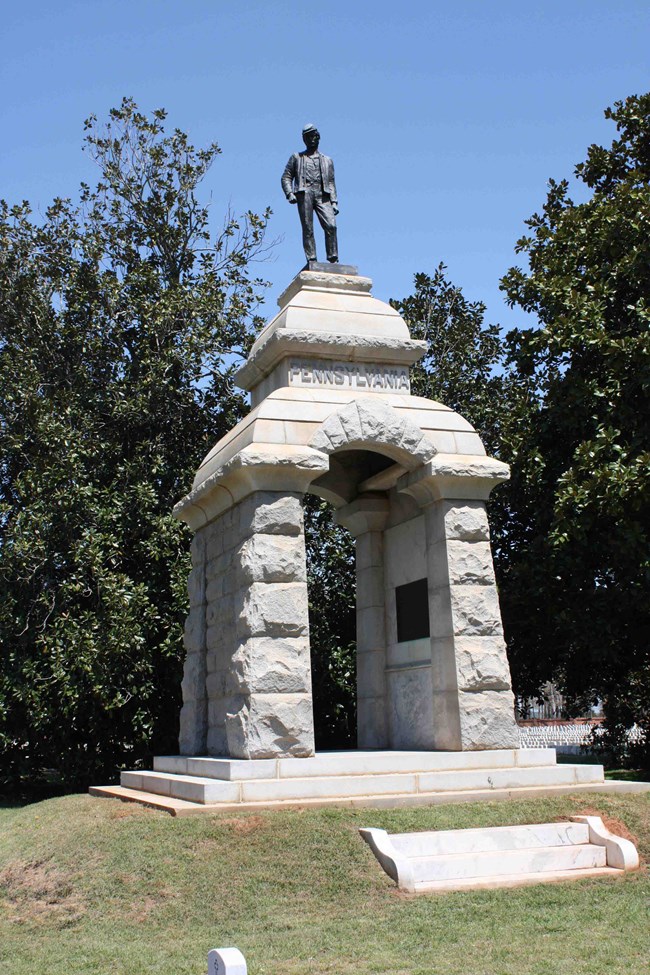
NPS/Photo Forever the monument will stand as silent reproach to the barbarianism that needlessly and wantonly took the lives of so many thousands of brave noble young Americans.
Pennsylvania monument dedication After the dedication of Providence Springhouse, the veterans visited the national cemetery to pay their respects to the men who never left. While walking among the long rows of white stones, they noticed a tall monument. The old men gathered around to admire the New Jersey monument and its granite soldier keeping a watchful eye over the graves. The men agreed that Pennsylvania should erect a memorial to honor their comrades who rested in the cemetery. Returning to Pennsylvania, the group of men quickly contacted their local state representatives about introducing a bill to erect a memorial for those who suffered at Andersonville. The state had dedicated a monument at Chickamauga National Military park, and a group of veterans were lobbying for a monument at Shiloh National Military Park, so it only seemed fitting that the state honor the 1,849 Pennsylvania soldiers who perished in the prison. Working to guarantee that the prisoners of war were not forgotten, the men contacted Governor William Stone. The governor, a former Union veteran, supported the idea, and in early October 1901, the Pennsylvania legislature passed a bill authorizing the erection of a monument at Andersonville. The state appropriated $25,000 for the task, and Stone approved the project but withheld the approval of the money due to insufficient funds. To show his continued support for the memorial, the governor went ahead and appointed a commission of five men. Three of the commissioners understood the prisoner of war experience as they had lived it during the war. Senator Ezra Ripple, William L. Ziegler and Congressman Harry White were appointed to the commission and had served with infantry regiments and been held captive. Two of the appointees, James Atwell and James D. Walker, had served with Knapp's independent Battery E during the war, and William H. Bricker had served with the Third Pennsylvania Cavalry. The men wasted no time. They met on October 25, 1901, in Harrisburg, Pennsylvania, to organize and begin work. The group elected James Atwell, the commander of the Ex-Union Prisoners of War Association, president of the commission. Ezra H. Ripple, a former Union Colonel and Andersonville prisoner, agreed to serve as the secretary and treasurer. Immediately, the committee sent out requests for design bids to make a decision about what type of memorial to erect. After much discussion, the committee members agreed that they would be able to make a better decision after they selected a spot in the cemetery. After selecting the perfect spot, Bricker agreed to supervise the construction of the memorial and traveled to Chickamauga National Military Park to inspect monuments made of southern granite there. The following April, the committee met again to decide on a monument design. Six monument companies made the final cut and were some of the largest monument and granite companies in the country. Among them was Miller and Clark Granite and Monumental Works of Americus, Georgia. This company was familiar with the prison site as it was only a few miles down the road. The commissioners spent three days reviewing each design before selecting one submitted by Miller and Clark. The chosen monument would rise thirty-five feet above the ground and be surmounted by a dome arcade. The barre granite memorial would feature two gothic entrances, which allowed visitors to enter and admire a bronze relief of prisoners getting water from Providence Springs. Miller and Clark commissioned an artist to create the bronze figure on top. The eight-foot bronze statue presented a prisoner of war & quote in appearance dejected and sad, facing forward and overlooking the cemetery as if looking in sorrow on the graves of the honored dead.
From the book: A History of Andersonville Prison Monuments. By Stacy W. Reaves |
Last updated: May 8, 2019
